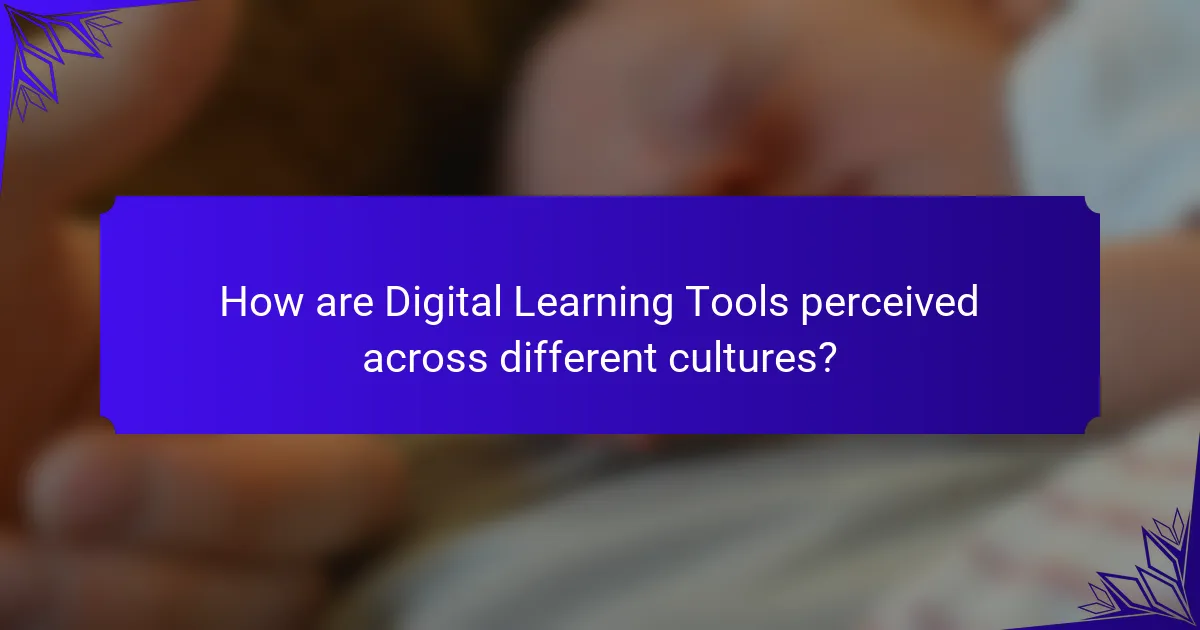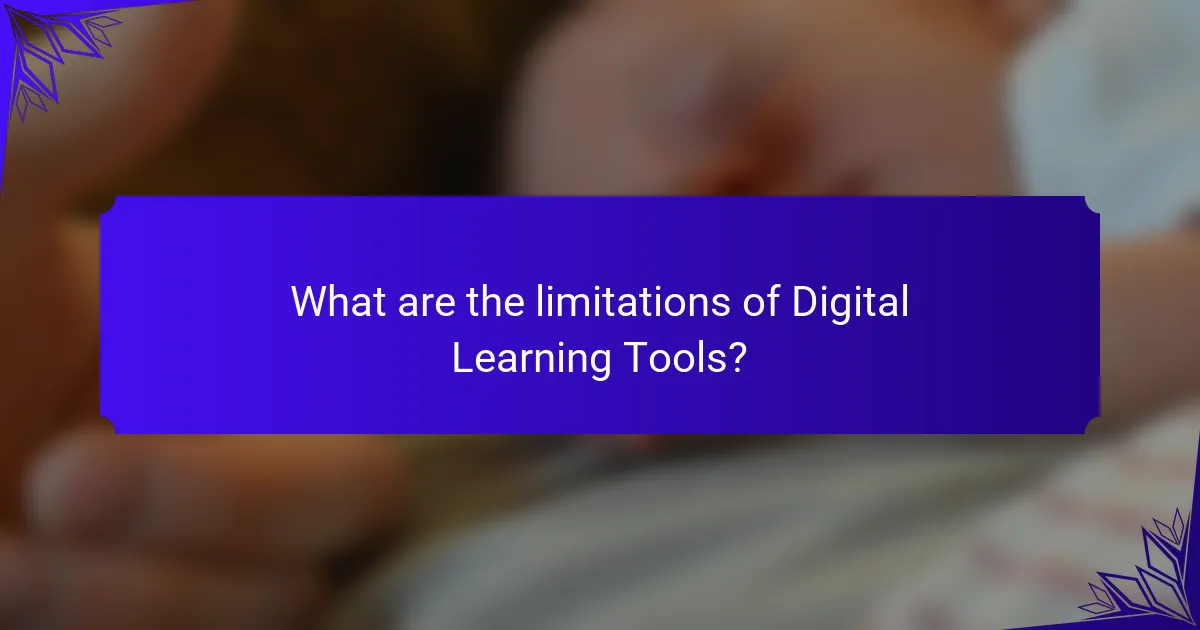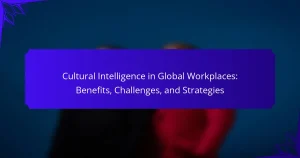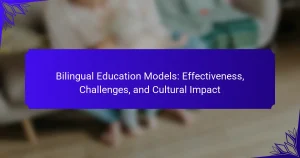Digital learning tools enhance educational experiences through interactivity and personalization. Their adaptation improves engagement and retention, while benefits include flexibility and scalability. Cross-cultural applications promote global collaboration, influenced by cultural attitudes towards technology. Understanding these nuances is essential for effective digital learning strategies.

What are Digital Learning Tools?
Digital learning tools are technologies that facilitate education and training through digital means. These tools enhance learning experiences by providing interactive, personalized, and accessible content. Their adaptation in various educational settings improves engagement and retention. Benefits include flexibility, scalability, and the ability to cater to diverse learning styles. Cross-cultural applications of digital learning tools promote global collaboration and knowledge sharing, breaking geographical barriers.
How do Digital Learning Tools adapt to different learning environments?
Digital learning tools adapt to different learning environments by utilizing personalized learning algorithms, real-time feedback, and diverse content formats. These tools enhance engagement and accommodate various learning styles, enabling students to learn at their own pace. They also support collaborative learning through features like discussion forums and group projects, fostering cross-cultural interactions. As a result, digital learning tools can effectively meet the needs of diverse educational settings, promoting inclusivity and accessibility.
What are the core benefits of using Digital Learning Tools?
Digital learning tools enhance education by providing accessibility, engagement, and personalized learning experiences. They support diverse learning styles and foster collaboration among students. Additionally, these tools facilitate real-time feedback, allowing for continuous improvement and adaptation of teaching methods. Their cross-cultural applications promote inclusivity and broaden educational reach globally.
How do they enhance engagement and motivation?
Digital learning tools enhance engagement and motivation through interactive features and personalized learning experiences. These tools often incorporate gamification elements, which create a competitive yet enjoyable learning environment. For example, progress tracking and instant feedback keep learners motivated and invested in their education. Additionally, adaptive learning technologies tailor content to individual needs, ensuring that learners remain challenged without becoming overwhelmed. This personalized approach fosters a deeper connection to the material, ultimately leading to improved learning outcomes.
What role do they play in personalized learning?
Digital learning tools play a crucial role in personalized learning by adapting content to individual student needs. These tools utilize data analytics to assess learning styles, preferences, and progress, enabling tailored educational experiences. For instance, adaptive learning platforms adjust difficulty levels based on real-time performance metrics, enhancing engagement and comprehension. Additionally, digital tools facilitate cross-cultural applications by providing diverse resources that cater to various learning contexts, promoting inclusivity and accessibility. This adaptability is a unique attribute of digital learning tools, making them essential in modern education.
What unique features differentiate various Digital Learning Tools?
Digital learning tools differ significantly through features like adaptability, user interface, content variety, and analytics capabilities. Adaptability allows for personalized learning experiences, while an intuitive user interface enhances engagement. Diverse content formats, such as videos and interactive quizzes, cater to various learning styles. Advanced analytics provide insights into learner progress, enabling targeted interventions.
How does gamification enhance the learning experience?
Gamification enhances the learning experience by increasing engagement and motivation. It incorporates game elements, such as rewards and challenges, into educational settings. This approach leads to improved retention of information and fosters a sense of achievement among learners. For example, studies show that gamified learning can increase student participation by up to 60%. Additionally, it encourages collaboration and competition, which can enhance social learning experiences. Overall, gamification transforms traditional learning into an interactive and enjoyable process.
What is the impact of artificial intelligence on Digital Learning Tools?
Artificial intelligence significantly enhances digital learning tools by personalizing learning experiences and improving engagement. AI algorithms analyze user data to tailor content, making education more effective. For example, adaptive learning platforms adjust difficulty levels based on student performance, promoting better retention. Additionally, AI-powered chatbots provide instant support, addressing learner queries in real-time. This technology fosters cross-cultural applications by making educational resources accessible in multiple languages, bridging gaps in diverse learning environments. Overall, the integration of AI in digital learning tools optimizes educational outcomes and accessibility.
What rare attributes can be found in specific Digital Learning Tools?
Digital learning tools can exhibit rare attributes such as adaptive learning algorithms, which tailor content based on individual progress. Another rare attribute is multilingual support that allows tools to function seamlessly across diverse languages and cultures. Some tools incorporate gamification elements that enhance engagement through unique reward systems. Additionally, advanced analytics features provide insights into learner behavior that are not commonly found in standard tools. Lastly, integration capabilities with other educational platforms can be a distinctive attribute, enabling a cohesive learning experience.
How do cultural contexts influence the design of Digital Learning Tools?
Cultural contexts significantly influence the design of digital learning tools by tailoring content to diverse learner needs. Different cultures prioritize various learning styles, communication methods, and values, affecting user engagement and effectiveness. For instance, collectivist cultures may favor collaborative features, while individualistic cultures might prefer personalized learning paths. Understanding these nuances ensures digital tools are relevant and accessible, enhancing educational outcomes across global audiences. This adaptation reflects a unique attribute of successful digital learning tools, which is their ability to resonate with cultural diversity.
What are the challenges faced by Digital Learning Tools in cross-cultural applications?
Digital learning tools face significant challenges in cross-cultural applications, primarily related to language barriers, cultural relevance, and technological access. Language differences can hinder comprehension and engagement, while cultural nuances may affect content interpretation and user interaction. Additionally, varying levels of technological infrastructure and access can limit the effectiveness of these tools in different regions.

How are Digital Learning Tools perceived across different cultures?
Digital learning tools are perceived differently across cultures, influenced by educational values and technological accessibility. In collectivist societies, collaboration through digital tools is emphasized, enhancing group learning. Conversely, in individualistic cultures, tools are often seen as means for personal development and self-paced learning.
Cultural attitudes towards technology also shape perceptions. For instance, in countries with high digital literacy, tools are embraced for their innovative potential. In contrast, regions with limited access may view them as supplementary rather than essential.
Research indicates that local adaptations of digital tools enhance acceptance, making them more relevant. For example, language localization and culturally relevant content increase engagement and effectiveness.
Overall, understanding these cultural nuances is crucial for developing effective digital learning strategies globally.
What adaptations are necessary for successful implementation in diverse regions?
Successful implementation of digital learning tools in diverse regions requires cultural sensitivity, technological accessibility, and localized content. Adapting tools to meet the unique educational needs and preferences of each region enhances engagement and effectiveness. For example, incorporating local languages and culturally relevant examples fosters better understanding. Additionally, addressing varying levels of technology infrastructure ensures that all learners can access these tools effectively.
What are the best practices for integrating Digital Learning Tools in multicultural classrooms?
Integrating digital learning tools in multicultural classrooms enhances engagement and accessibility. Best practices include selecting culturally relevant content, providing multilingual support, and encouraging collaboration among students. Additionally, training educators to use these tools effectively fosters an inclusive environment. Regular feedback from students helps to tailor the tools to diverse learning styles.

What are the limitations of Digital Learning Tools?
Digital learning tools face several limitations that can impact their effectiveness. These include technological barriers, lack of personal interaction, and varying levels of digital literacy among users.
Technological barriers can hinder access, especially in regions with poor internet connectivity. This limitation affects the ability to fully utilize digital learning platforms.
Lack of personal interaction can lead to feelings of isolation among learners. This absence may diminish engagement and motivation, making it challenging to replicate the benefits of traditional classroom settings.
Varying levels of digital literacy create disparities in learning experiences. Some users may struggle to navigate digital tools, impacting their overall learning outcomes.
Addressing these limitations is crucial for enhancing the effectiveness of digital learning tools across diverse educational contexts.
How can educators overcome the challenges associated with Digital Learning Tools?
Educators can overcome challenges with digital learning tools by embracing training, fostering collaboration, and adapting to diverse learning needs. Effective training programs enhance educators’ skills, while collaboration among peers promotes sharing best practices. Tailoring tools to meet unique student needs increases engagement and effectiveness.
What are the common mistakes to avoid when using Digital Learning Tools?
Common mistakes when using digital learning tools include inadequate training, neglecting user feedback, and failing to adapt content for diverse learners. These errors can hinder engagement and limit the effectiveness of the tools. For example, not providing sufficient training can lead to underutilization of features, while ignoring feedback may result in missed opportunities for improvement. Additionally, overlooking cultural differences can alienate users and reduce the overall impact of the learning experience.

What insights can experts provide on the future of Digital Learning Tools?
Experts predict that digital learning tools will increasingly prioritize personalized learning experiences. They emphasize the importance of adaptability, allowing tools to cater to individual learning styles and paces. Furthermore, the integration of artificial intelligence will enhance these tools, providing real-time feedback and support. Cross-cultural applications will expand, making education more accessible globally. The future will likely see a blend of synchronous and asynchronous learning methods, fostering collaboration across diverse educational environments.
How can educators optimize the use of Digital Learning Tools for better outcomes?
Educators can optimize digital learning tools by integrating them thoughtfully into their teaching strategies. Effective adaptation involves aligning tools with learning objectives and student needs. Benefits include enhanced engagement, personalized learning experiences, and improved collaboration. Cross-cultural applications allow diverse student populations to access tailored resources, fostering inclusivity and broadening perspectives.


